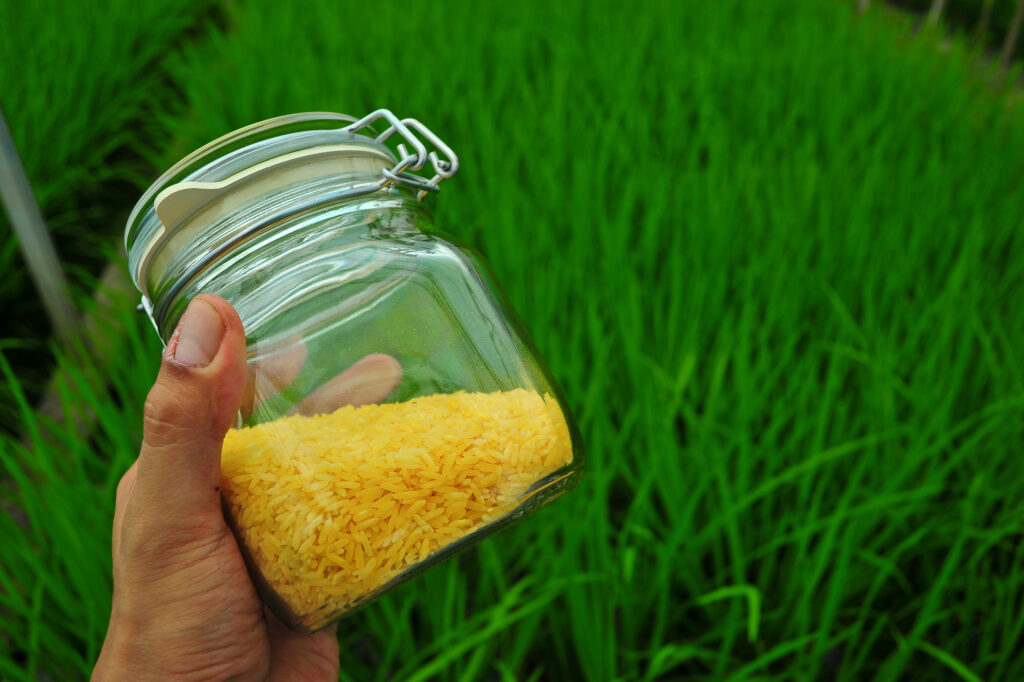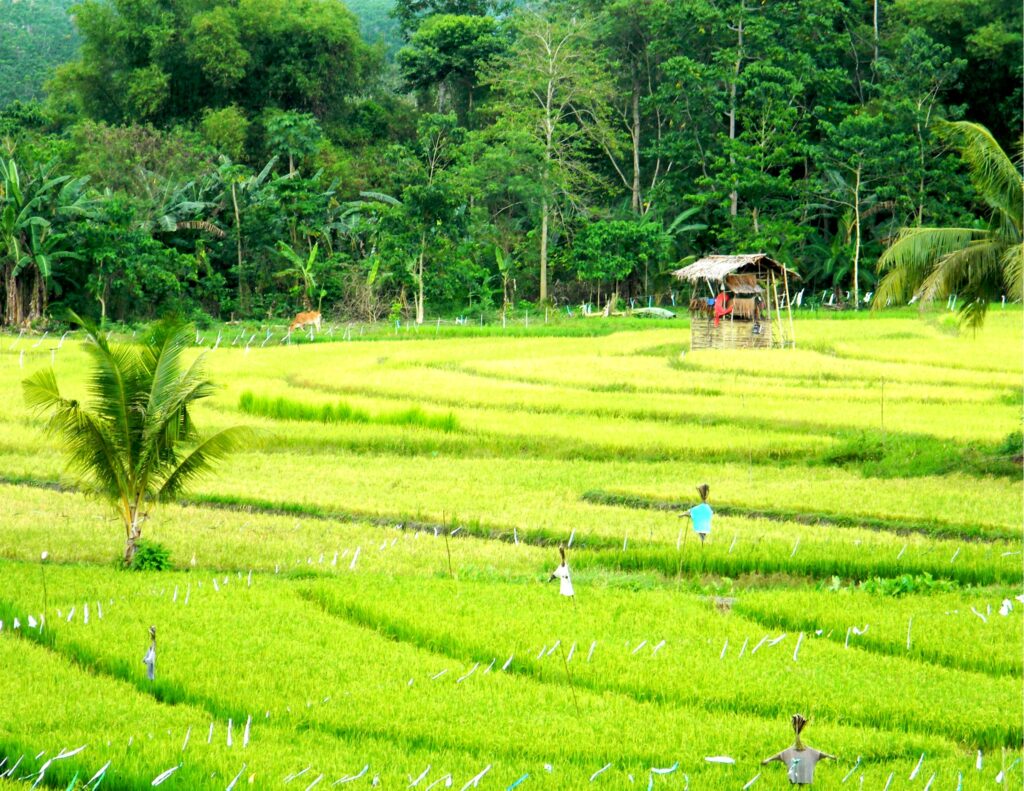Text and Photos by Henrylito D. Tacio
Additional Photo from IRRI
A “rice that could save a million lives a year,” so said Swiss plant researcher Ingo Potrykus said of golden rice in 2000. Two decades later, golden rice is still out of reach for most people who would benefit from it.
Although golden rice was approved for direct use as food, feed, or for processing in December last year, it may take at least three more years before it can be available on the food tables of Filipinos.
It’s still a long way to go, according to Dr. Reynante Ordonio, the senior science research specialist of the Philippine Rice Research Institute (PhilRice), an attached agency of the Department of Agriculture.
In an exclusive interview with Dr. Ordonio in 2018, he said that golden rice would be made available for commercial production “after it has received all the necessary permits.”

Golden rice (Photo from IRRI) 
Rice fields
Last May 13, he said in a virtual briefing during the start of the 16th National Biotechnology Week, “It really depends on the approval process, it can take more than a year. 2023 is our estimate. Personally, I’ve learned not to expect much but we remain hopeful.”
In a press statement released to the media, PhilRice said that golden rice “is now in the final stage of biosafety regulatory assessments. Once it gets the permit for commercial propagation anytime soon, we will be preparing for its deployment initially on a pilot scale in areas where malnutrition is high.”
Golden rice is a product of biotechnology, defined as “any technique that uses living organisms to make or modify a product, to improve plants or animals or to develop microorganisms for specific uses.”
The methodology seems like a work of fiction.
“Traditional methods of crop improvement require the mixing of genes by making specific crosses, observing and selecting for specific phenotypes [traits] in the offspring,” explains Dr. Frank A. Shotkoski, an adjunct professor at the Cornell University in the College of Life Science Department of Plant Breeding and Genetics. “This has been a very effective tool for crop improvement, and our ancestors have been quite successful in using these techniques to develop the productive, tasty and nutritious crops that we have today.”
But modern biotechnology completely changes that. “Biotechnology allows us to introduce genes into crops that could never be achieved using traditional or conventional methods, because the gene tied to a specific trait (that is, insect resistance, disease resistance, herbicide tolerance, etc.) doesn’t exist in species,” Dr. Shotkoski points out.
In recent years, modern biotechnology – through genetic engineering – has been used to increase plant and animal food production, to diagnose disease, improve medical treatment, produce vaccines and other useful drugs, and to help dispose of industrial wastes. This paved way for the buzzword, genetically modified organisms (GMOs).
In the case of golden rice, respected scientists Ingo Potrykus and Peter Beyer first used a gene from daffodil and an ordinary microbe and introduced it to rice through genetic engineering. Using the same microbe and another gene from yellow corn, the second version of golden rice came into existence. The new form has been found to contain 20 times more beta carotene than the original one.
The development would have been welcomed with much fanfare. But such is not the case. “GMOs worldwide are governed by a stringent biosafety regulatory process starting from their development to commercialization,” says Dr. Ordonio. “The biosafety procedure involves a series of checkpoints to ensure that GMOs or their by-products will meet the expected level of safety to health and the environment.
“Going through this procedure doesn’t mean that GMOs have higher risks as even ordinary foods such as peanuts, milks, melons, breads, and shrimps can cause harm as sources of allergens,” Dr. Ordonio continues. “In fact, GMOs can even be a lot safer because of this strict biosafety process.”
Take the case of golden rice, which had to go through a series of rigorous testing and regulatory procedures. To ensure that golden rice is safe for the environment and health, the planting materials used were subjected to confined field-testing in fenced and isolated areas for at least two cropping seasons in 3 different locations in the country.
“During the tests, any discrepancy or variation from the original variety in terms of appearance, and any unusual disease, pest, or weed incidence at the sites were carefully assessed,” Dr. Ordonio reports.
The Biosafety Committee of the Department of Science and Technology (DOST) provides overall supervision along with scientist representatives and members of the local community who jointly form the Institutional Biosafety Committee of each site; see to it that biosafety guidelines are strictly followed. Among these guidelines is preventing the intentional or unintentional release of viable seeds or plants from the site and the proper disposal or transport of transgenic materials.
Once the five best-performing lines of the planting materials are identified, these are to be forwarded to a season of field trials under the supervision of the Bureau of Plant Industry of the Department of Agriculture (DA), as stated in the Joint Department Circular No. 1 Series of 2016 pertaining to the handling and use, transboundary movement, release, and management of GMOs.
Aside from the two government agencies, other departments involved are the Departments of Health, Environment and Natural Resources, and Interior and Local Government. This collaborative assessment further ensures the safety of golden rice.
Now, the big question is: Is golden rice effective?
“To measure the potential nutritional impact of golden rice, let’s keep in mind these three Bs: beta-carotene, bioavailability, and bioconversion,” states PhilRice, which collaborates with the International Rice Research Institute (IRRI) in the possible production of golden rice in the country.
“The yellow grains of golden rice demonstrate the presence of beta-carotene, which is only available in the leaves and stems of ordinary rice plants. Adding genes from corn and a common soil microorganism enables the plant to produce beta-carotene in the rice grain, while maintaining all other characteristics of ordinary rice.”
Beta-carotene, science says, is an ideal source of vitamin A because the human body only converts as much as it needs.
“Rice has a simple and easily digestible food matrix, which allows for a high bioavailability and bioconversion of beta-carotene into vitamin A,” PhilRice explains. “Put simply, bioavailability is the total amount of the nutrients available in the rice grain — in this case, beta-carotene and other useful carotenoids — that can be digested, stored, and converted by the human body.”
Because beta-carotene has a natural tendency to degrade over time, the PhilRice project team monitors beta-carotene content at various stages of the project, from harvest to storage to cooking: estimating from 100 grams of milled golden rice stored for two months in normal conditions, with 30% cooking losses in its calculations.
“Measurements at this stage show that there is sufficient beta-carotene in Golden Rice to meet the 30-50% estimated average requirement (EAR) of vitamin A for young children and mothers or lactating women.” PhilRice reports.
Once the bioavailability of beta-carotene is estimated, the next factor to consider when calculating the potential vitamin A contribution of golden rice is the bioconversion rate or the percentage of the absorbed carotenoids that is converted by the human body. This is measured in terms of retinol activity equivalents (RAE).
Studies show that beta-carotene bioconversion varies significantly across different plant food sources. Staple crops and other foods with simple food matrices show a more efficient bioconversion rate than fruit or vegetable sources of beta-carotene.
PhilRice says golden rice has a bioconversion rate of 3.8:1 — this means that the human body only needs 3.8 micrograms of beta-carotene from golden rice to convert into one microgram RAE (vitamin A). This is equivalent to one cup of cooked golden rice to provide 30-50% EAR of vitamin A for pre-school children and two cups for school children and adults.
In comparison, 21 micrograms of beta-carotene from cooked and pureed spinach and 15 micrograms from cooked and pureed carrots are needed by the body to convert into one microgram RAE.
“The efficient bioconversion rate of Golden Rice is promising from a dietary perspective, given rising food costs and the persistent inadequacy of Filipino diets in terms of providing macro- and micronutrients,” PhilRice says.
The 2018 FNRI Expanded National Nutrition (ENNS) Survey shows that rice continues to be a top source of energy across all Filipino households regardless of socio-economic status. While animal-based food consumption increases with income, consumption of fruits and vegetables is consistently low across all households.
While the 2018 ENNS shows a slight decline in Vitamin A deficiency (VAD) among young children, this continues to be a severe problem among children aged 12-23 months, as well as in children belonging to the poorest households. Data also shows the chronic inadequacy of Vitamin A intake in the Filipino diet and the lower prevalence of the recommended twice-yearly Vitamin A supplementation even among non-VAD children.
Young children are disproportionately affected by VAD because proper nutrition during the first 1000 days of life directly affects physical and cognitive development. “The prevalence of undernutrition, stunting, wasting, and anemia is higher among VAD children, which — if left untreated — will have lasting effects on their future productivity and quality of life,” PhilRice points out. “This underscores the need for a consistent supply of Vitamin A-rich food sources.”
A simulated analysis conducted shows that even substituting small amounts of ordinary rice with Golden Rice can produce a meaningful improvement in vitamin A intake among target populations. This demonstrates its potential as an affordable and sustainable means of providing needed micronutrients in the daily diet of Filipinos, supplementing other plant and animal food sources of vitamin A.
The agriculture sector has a key role to play in improving the quality of Filipino diets through nutrition-sensitive practices that improve affordability and accessibility to a diverse range of foods and by increasing the nutrient content of already accessible and affordable staple crops like rice.
“By working to bring golden rice to the tables of those who need it the most, PhilRice is fulfilling its mandate to provide safe and nutritious rice, and paves the way for agriculture and nutrition sectors to work closely together to improve the health, well-being, and quality of life of all Filipinos,” PhilRice concludes.

